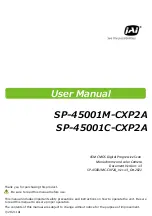
Prosilica GE Technical Manual V2.2.1
11
Introduction
Identifying debris
Debris on the image sensor or optical components appears as a darkened area
or smudge on a camera image. Do not confuse this with a pixel defect which
appears as a distinct point.
Locating debris
First determine whether the debris is on the sensor glass, IR filter (if used), or
lens. The farther away the debris is from the sensor, the blurrier the debris
appears on a camera image.
Stream a live image from the camera using a uniform target, such as a piece
of paper. To determine if the debris is on the camera lens, rotate the lens
independent of the camera. If the spot moves, the debris is on the lens.
Otherwise, the debris is on the IR filter (if used) or sensor glass.
Color cameras with IR filter
Prosilica GE color cameras are equipped with an IR filter. With no lens or lens
cap on a camera, the IR filter is exposed and debris can accumulate on it. This
is the most probable location for debris. It should not be necessary to remove
the IR filter for cleaning. Clean the outside of the IR filter glass using the
techniques explained in the next section.
If it is determined that the debris is on the inside surface of the filter glass, or
on the sensor glass, IR filter removal is necessary. Depending on the
manufacturing date of your Prosilica GE camera, the IR filter may be slot type,
or pinhole type. Slot type filters can be removed using a small flat head screw
driver. Pinhole type filters require a pin spanner wrench for removal.
Cleaning with air
Blow directly on the contaminated surface with moderate pressure, clean
compressed air.
Caution
Do not touch any optics with fingers. Oil from fingers can
damage fragile optical coatings.
Note
A pin spanner wrench suitable for IR filter removal is available
for purchase from Allied Vision.
Order code: E9020001












































